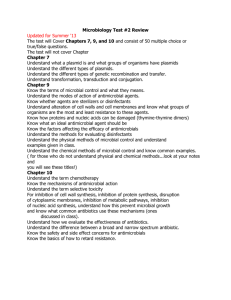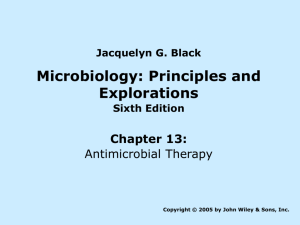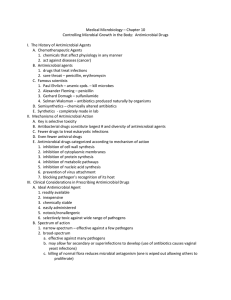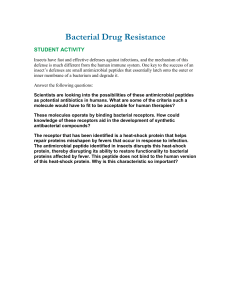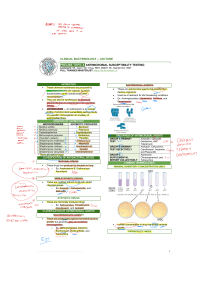Nursing college,
advertisement
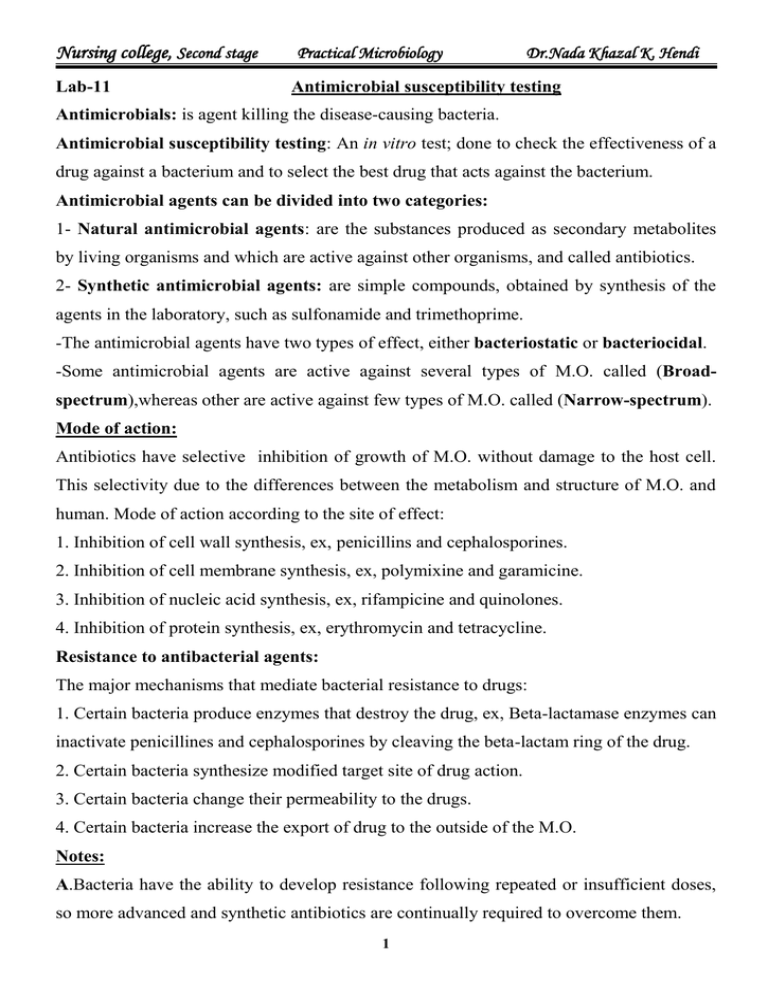
Nursing college, Second stage Lab-11 Practical Microbiology Dr.Nada Khazal K. Hendi Antimicrobial susceptibility testing Antimicrobials: is agent killing the disease-causing bacteria. Antimicrobial susceptibility testing: An in vitro test; done to check the effectiveness of a drug against a bacterium and to select the best drug that acts against the bacterium. Antimicrobial agents can be divided into two categories: 1- Natural antimicrobial agents: are the substances produced as secondary metabolites by living organisms and which are active against other organisms, and called antibiotics. 2- Synthetic antimicrobial agents: are simple compounds, obtained by synthesis of the agents in the laboratory, such as sulfonamide and trimethoprime. -The antimicrobial agents have two types of effect, either bacteriostatic or bacteriocidal. -Some antimicrobial agents are active against several types of M.O. called (Broadspectrum),whereas other are active against few types of M.O. called (Narrow-spectrum). Mode of action: Antibiotics have selective inhibition of growth of M.O. without damage to the host cell. This selectivity due to the differences between the metabolism and structure of M.O. and human. Mode of action according to the site of effect: 1. Inhibition of cell wall synthesis, ex, penicillins and cephalosporines. 2. Inhibition of cell membrane synthesis, ex, polymixine and garamicine. 3. Inhibition of nucleic acid synthesis, ex, rifampicine and quinolones. 4. Inhibition of protein synthesis, ex, erythromycin and tetracycline. Resistance to antibacterial agents: The major mechanisms that mediate bacterial resistance to drugs: 1. Certain bacteria produce enzymes that destroy the drug, ex, Beta-lactamase enzymes can inactivate penicillines and cephalosporines by cleaving the beta-lactam ring of the drug. 2. Certain bacteria synthesize modified target site of drug action. 3. Certain bacteria change their permeability to the drugs. 4. Certain bacteria increase the export of drug to the outside of the M.O. Notes: A.Bacteria have the ability to develop resistance following repeated or insufficient doses, so more advanced and synthetic antibiotics are continually required to overcome them. 1 Nursing college, Second stage Practical Microbiology Dr.Nada Khazal K. Hendi B.Certain bacteria are not only resistant to drug but require it for growth, called drugdependent bacteria. C.Most drug resistance is due to a genetic change in bacteria(1)due to mutation in bacterial chromosome, inherited (2) acquired resistance due to acquisition of genetic materials. Methods of antimicrobial susceptibility testing: Because the bacteria rapidly develop resistance, therefore; they should be tested for antimicrobial susceptibility by one of the following methods: 1. Conventional testing methods, such as disc diffusion and dilution tests. 2. Commercial testing methods, such as E-test. Factors affecting antimicrobial susceptibility in vitro: a) Type and components of the medium. b) Type of inoculating method. c) Number and activity of inoculated bacteria. d) Stability and concentration of the used drug. e) Temperature and time of incubation. Disc diffusion method (Kirby and Bauer, 1966) i. Preparation of bacterial suspension by taking 5 colonies of young culture and adding it to tube contains 5 ml of broth medium then this tube will be incubated at 37°C for 5 hours. ii. The turbidity of bacterial suspension will be compared with the standard McFarland tube for determination of bacterial cell number that used in the inoculation. iii. About 0.1 ml of the bacterial suspension is spread over a solid medium (Muller-Hinton agar medium) by swabbing (vertical and horizontal directions). The inoculated plate is left to dry at room temperature for 15 minutes. iv. Antibiotic-impregnated filter paper discs are placed, 4-6 discs on each plate by a sterile forceps. The plate will be incubated at 37°C for 18-24 hours. v. The result will be recorded by measuring the inhibition zones (in mm). The interpretation of these results as sensitive or resistant according to a standard document of CLSI (clinical and laboratory standard institutes). The efficacy of drug combination can be estimated as synergistic (enhancement of efficacy of drug in the presence of other drug), or antagonistic (impairment of efficacy) or indifferent (no change in the presence of other drug). 2 Nursing college, Second stage Practical Microbiology 3 Dr.Nada Khazal K. Hendi


